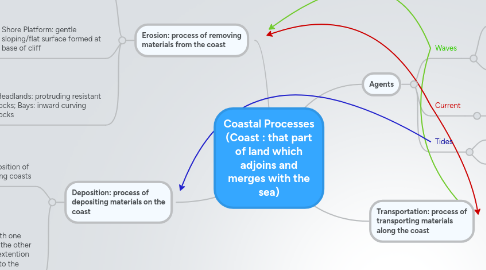
1. Erosion: process of removing materials from the coast
1.1. Cliff: high steep rock facing a coast
1.1.1. 1. Rocky coast repeatedly washed by waves
1.1.2. 2. Weakens rocks to cut a notch, forms caves
1.1.3. 3. Part of cave collapses, forms cliff
1.2. Shore Platform: gentle sloping/flat surface formed at base of cliff
1.2.1. 1. Waves wash over and erode cliffs
1.2.2. 2. Over time, the cliffs retreat inwards
1.3. Headlands: protruding resistant rocks; Bays: inward curving rocks
1.3.1. 1. Rocks in the coasts have different resistance to erosion
1.3.2. 2. More resistant rocks remains stable; Less resistant rocks worn out rapidly
2. Deposition: process of depositing materials on the coast
2.1. Beaches: deposition of sediments along coasts
2.1.1. Calm weather: beaches build up; deposition of sediments Coastal storm: materials are removed, beaches recede
2.1.2. Coarser materials = Heavier weight = Steeper; Finer materials = Lighter weight = Gentler
2.2. Spit: long, narrow ridge of sand, with one end attached to the mainland, and the other protruding into the sea; Tolombo: extention of a spit joining an offshore island to the mainland
2.2.1. 1. Longshore current reach a bay/bend, encounter shallow shelter water, reduces energy, forcing deposition
3. Transportation: process of transporting materials along the coast
4. Agents
4.1. Waves
4.1.1. Affected by Wind energy & Fetch
4.1.2. Swash & Backwash
4.1.2.1. High energy = backwash stronger = destructive
4.1.2.2. Low energy = swash stronger = constructive
4.2. Current
4.2.1. Longshore current
4.3. Tides
4.3.1. 1. High tide
4.3.2. 2. Low tide
